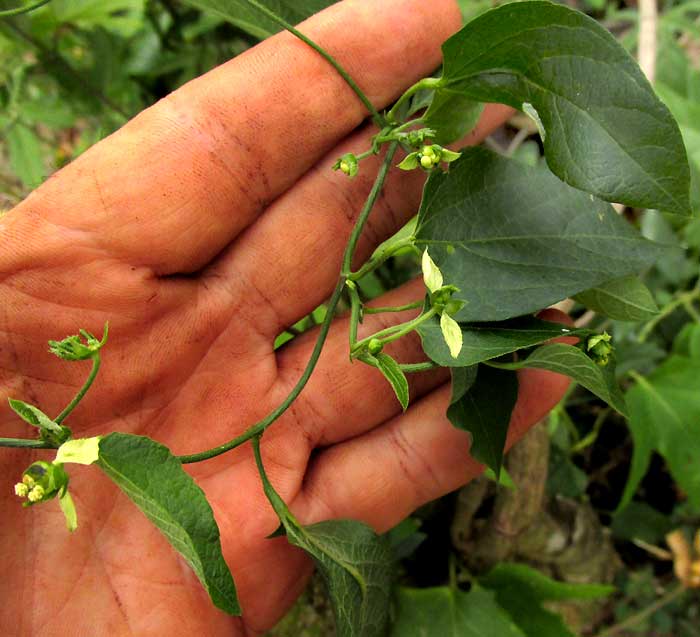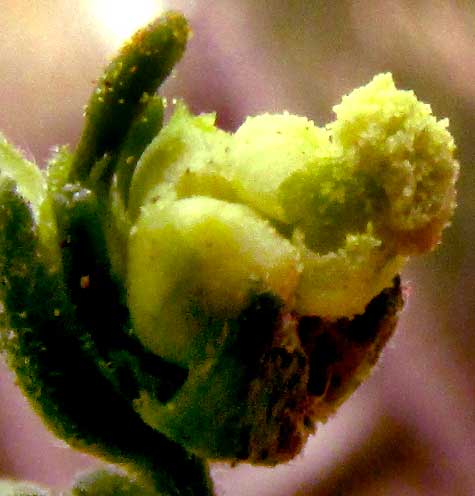Excerpts from Jim Conrad's
Naturalist Newsletter
from the March 15, 2019 Newsletter issued from Rancho Regensis north of Valladolid, Yucatán, MÉXICO;
elevation ~40m (~130 ft), N~20.876°, W~88.170°
"SCHOTT'S SPURGECREEPER"
Twining up a tree along a cowpath through the woods, a wiry, modest little vine caught my eye because it bore several pairs of tiny, white leaves among larger green ones, as shown below:

At first glance it seemed that the vine's terminal sprouts were withering and turning white, which made sense because the current dry season is causing many green things to die back. However, these white leaves consistently occurred in pairs on a vine that otherwise bore only one leaf per stem node, plus they were all the same size. Examining between two of those white leaves, structures turned up indicating that the white leaves were part of a flower structure. Below, you can see one of the hard-to-interpret floral items:

The erect, green, club-shaped items appear to be dusted with pollen grains, and seem to be associated with leafy, toothed-fringed, triangular bracts arising below them. We've seen such a weird arrangement before -- though that vine was much larger, the leaves deeply lobed, and the bracts were spiny -- on the commonly occurring Spurgecreeper vine, Dalechampia scandens, a member of the Spurge or Euphorbia Family. That species can be compared at www.backyardnature.net/mexnat/dalecham.htm
When that species was documented, it became apparent that the green, clublike items were the female flowers' styles. In the Euphorbia Family, flowers are unisexual, and in the genus Dalechampia both male and female unisexual flowers occur in each flower cluster. The white leaves on both sides of the clusters are modified -- one would guess -- to attract the attention of pollinators. Remembering all this, on this new vine I set about looking for flower clusters exhibiting male flowers, and found what's shown below:

The granular mass at the image's right is composed of pollen grains being shed by splitting anthers in a male flower. The spherical items in the picture's center are unopened buds of male flowers. At the left are three club-shaped styles. I believe the female flowers mature first, in clusters in which only the styles are evident, as in our first close-up, then later the styles dry up but remain in place as the male flowers mature. This prevents self-pollination.
So, was this a second dwarfish member of the genus Dalechampia? Another Dalechampia species was indeed listed for the Yucatan, and it matched our little vine.
This second species is DALECHAMPIA SCHOTTII, endemic just to the Yucatan Peninsula and northern Guatemala. It doesn't have a commonly used English name, so I think of it as Schott's Spurgecreeper.
In a 2010 paper published by GH Bolstad and others dealing with the pollination ecology of Dalechampia schottii it's said that our vine "rewards bees by secreting fully visible, deep-blue resin from a gland subtended by two conspicuous petaloid bracts that may play the role of advertisement." Our pictures show the petaloid bracts OK but I can't find deep-blue resin being secreted for bees.
Interestingly, Bolstad wanted to know whether the size of the white bracts influenced the number of seeds produced. They didn't, so apparently bees weren't much attracted to the flower clusters by the bracts. What attracted them was the deep-blue resin I can't find.
Sometimes what seems obvious just doesn't prove to be right at all, while something hidden turns out to be what's actually important. Thus spake our endemic little Dalechampia schottii.